You’ve probably heard of wooly nylon thread, but you’re not sure what it is or what it’s used for.
Anyone who sews knows the importance of thread. Not all threads are created equal, though. Different types of threads are better suited for different fabrics and projects. If you’re not familiar with wooly nylon thread, read on to learn more about it.
What is Wooly Nylon Thread
Wooly nylon thread is a specially designed stretch thread that is made from 100% nylon to use for sewing mostly very stretchy fabrics like spandex and other 4-way stretch knit fabrics.
Wooly nylon thread is known not only for its high elasticity but also for its softness, durability, vibrant shine, and strength. The thread is also very flexible and has a good recovery. It’s great for swimwear, athletic wear, activewear, lingerie, and garments that need a little extra stretch.
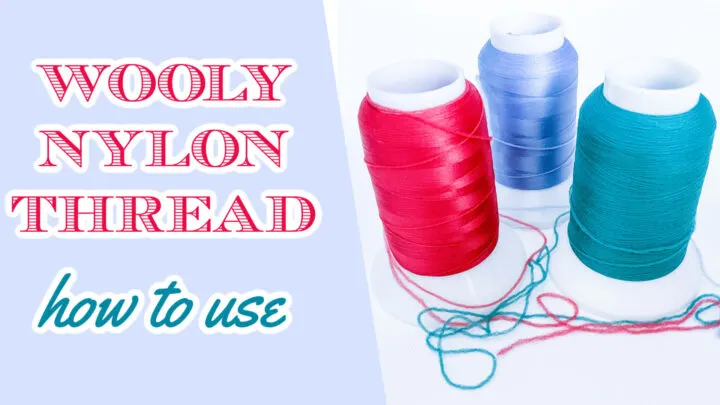
Note: Some of the links on this page are affiliate links. This means I will receive a commission if you order a product through one of my links. I only recommend products I believe in and use myself.
Sewing stretch fabrics can be difficult because regular thread often can’t handle the stretching and pulling. A regular thread might break or pop which can be really frustrating. But with wooly nylon thread, you can successfully sew stretch fabrics.
Wooly nylon thread is sold on cones and intended to be used on sergers. The thread is not spun, the fibers are relatively loose in a fuzzy (hence the name) shape like in the image below.
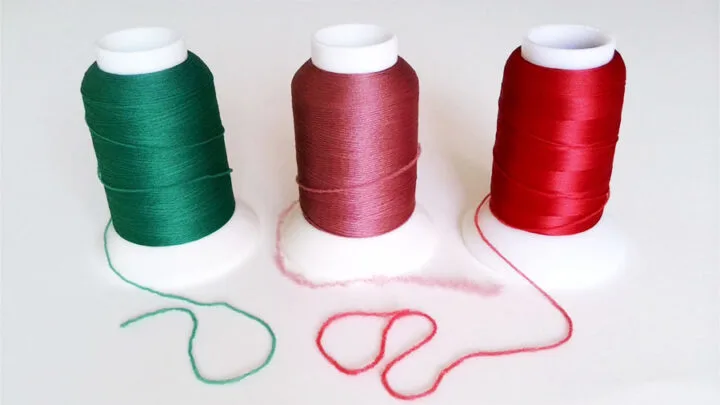
However, when the thread is stretched, the fibers straighten and the fuzzy “cylinder” becomes a regular very thin thread as can be seen in the following image. The thread on the upper part of the image is the same as the one on the lower side, but it is stretched.
This particular thread that I present here stretches to almost twice its original size. Because the thread is not actually stretching any fibers there is no danger of permanent loss of shape, like in the case of elastic, for example. This thread will easily adapt to various shapes of the material without fatigue or breaking.
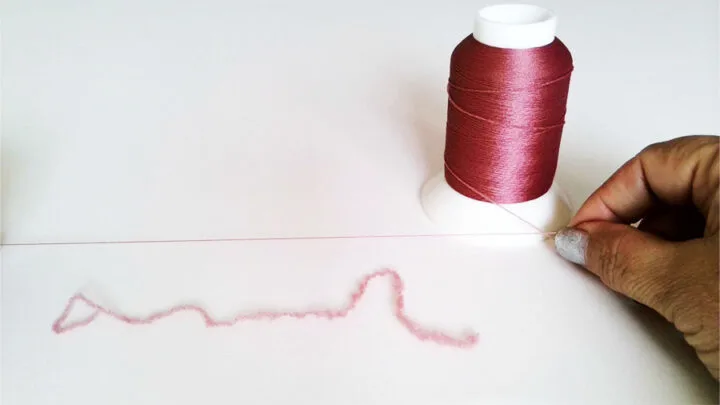
Not all wooly nylon threads have the same amount of stretch.
Some brands don’t label their thread “wooly nylon” and have a different name for it. Below is an image of the American & Efird brand MaxiLock (from my collection) described as “textured nylon”. It is a similar thing to wooly nylon as the small piece of thread coming out of the spool is showing. However, this particular thread I own is less stretchy than other wooly nylon threads.
Hint: always test an individual thread for stretch and strength, not all are the same.
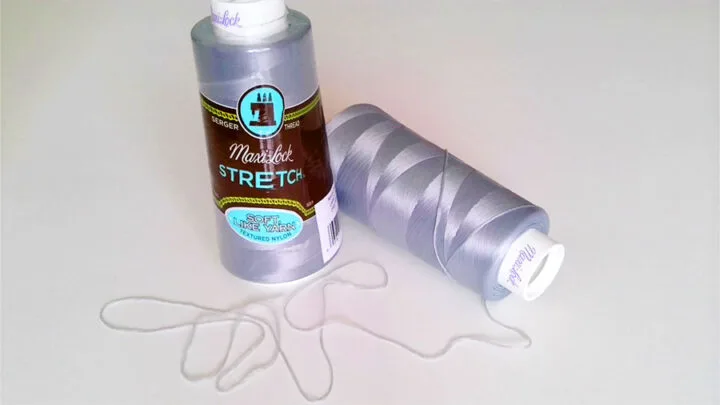
But there are also threads that look similar to wooly nylon but are made from 100% polyester. They are not wooly nylon threads but they are also stretchy and have almost the same characteristics.
For example, I bought spools called Polyarn (the Superior Threads brand) labeled “100% polyester” but they are the same kind as the wooly nylon, like in the image below. The thread has the same fuzzy appearance as you can see.
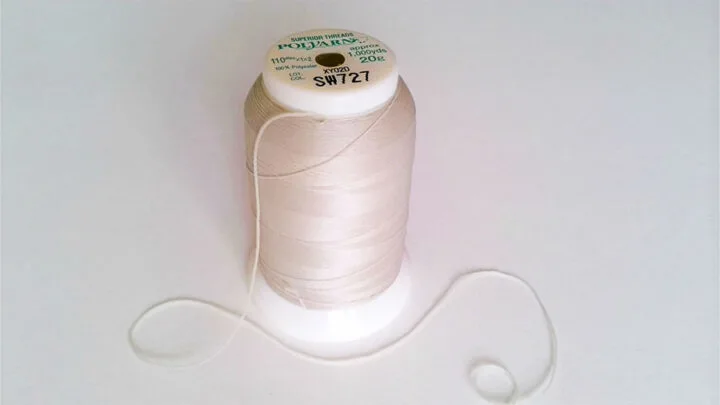
But there is some difference between this 100% texturized polyester thread and wooly nylon: Polyarn thread has a higher heat resistance than wooly nylon and this can be a big deal for some fabrics that need to be ironed or laundered at higher temperatures.
The term “wooly nylon thread” has a few variations and you can see sometimes the thread is called “woolly nylon” or “woollie nylon”.
I also need to mention here that you will sometimes find “bonded nylon thread” and some online stores will show that type together with wooly nylon when searching Amazon for example (because they are both 100% nylon). Bonded nylon is a thick and strong non-stretchy thread used usually for upholstery and has nothing in common with the wooly nylon.
How To Use Wooly Nylon Thread
The wooly nylon thread is best used for sewing 4-way stretch knits and other stretch fabrics because the thread is very stretchy. Wooly nylon thread is intended to be used on a serger (overlock) and coverstitch machine but with some adjustments, you can use it on a regular sewing machine too.
In fact, before the appearance of the modern stretch threads (like Eloflex) wooly nylon was the only good alternative for sewing knits and other stretch fabrics on a home sewing machine.
✅ Related tutorial: How to use Eloflex
Wooly nylon thread is a little more expensive than regular thread. For the price of a 1000 yards of wooly nylon thread I see on Amazon I can buy two 3000 yards cones of regular polyester thread, also good quality, so why use wooly nylon?
In my opinion, if there are other threads suited for my sewing projects I see no reason to go to the effort of using wooly nylon where it is not a must. If I can make do with regular threads, I will.
To sew fabrics with a low to moderate amount of stretch you can probably use your stretch stitches on your sewing machine and regular polyester thread. The resulting stitch will not be very stretchy, but the stitch design will allow some movement, so while not recommended, it is possible to use regular thread.
You can also use regular polyester thread in a serger (overlock) to sew moderately stretchy fabrics. The serger is a better choice because of the design of the stitch itself, the stretch is built in the stitch in such a way that allows the underlying material to move without transferring the force to the threads.
But the amount of stretch, however, is not great. So while there is some stretch, there is not a lot of it if you are using regular polyester thread.
For very stretchy fabrics like spandex and other 4-way stretch knits this is not possible though. Things like legging or bathing suits or any other stretch garments that need to be tight to accommodate the body will not work well with regular thread and this is where our wooly nylon comes to help.
Now let me show you some projects where I used wooly nylon thread.
I have a video tutorial on how to sew pajama shorts without a pattern.
And for these projects, I don’t have tutorials. Wooly nylon thread is perfect for sweater knits, rayon, and cotton knits.



You can also use wooly nylon thread with woven fabric that’s not even stretchy. This thread is good for sewing rolled hems when you are making tablecloths, napkins, placemats. It creates an attractive finish on home decor projects. Here is an example of a rolled hem on quilting cotton fabric made with wooly nylon in the loopers.
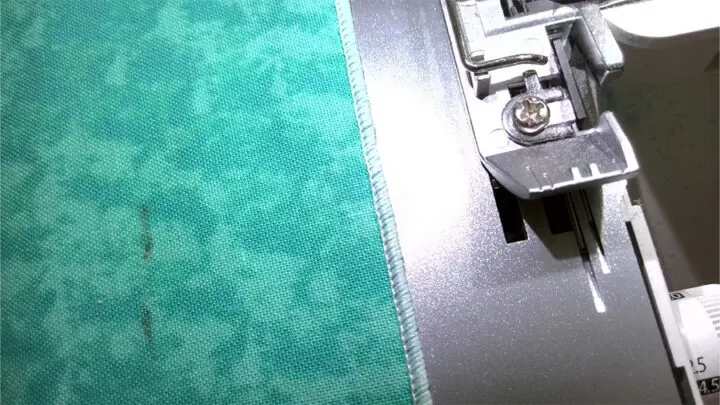
But if you use wooly nylon with cotton fabric you should remember that this thread is not really heat resistant and can melt if the iron temperature is set to cotton or linen. So use a pressing cloth in this case and don’t keep your iron on the threads for a long time. Or use Polyarn made from 100% polyester, it’s much more resistant to melting.
✅ Related tutorial: Pressing tools for sewing
Wooly nylon in a regular home sewing machine
In a regular sewing machine, you use wooly nylon only in the bobbin. Also, you will need to use one of the stretch stitches available on your sewing machine. You can’t use a regular straight stitch. If your sewing machine doesn’t have special stretch stitches, you will need to use a simple zig-zag stitch.
✅ Related tutorial: Types Of Stretch Stitches On A Sewing Machine
You can’t use the wooly nylon thread in the needle of a regular sewing machine and all manufacturers recommend you NOT use it in the needle. I did not try it myself but I assume the reason is simply that the thread, when not under tension, is fuzzy and would probably fray and be chewed by the sewing machine. I suggest, don’t try unless you don’t like your sewing machine 😀.
Nevertheless, if you read the reviews you will see that many one star reviews for wooly nylon threads are exactly because of this reason: incorrect usage. Example:
When I went to thread it through my machine it just frays. I even unspooled about 6ft, just in case it was the beginning part (which I’ve had issues with before).
When I wind the bobbin with wooly nylon I do it manually because I think the automatic winder puts too much tension on the thread. If you want to know how to wind a bobbin by hand check out my tutorial How to thread a bobbin.
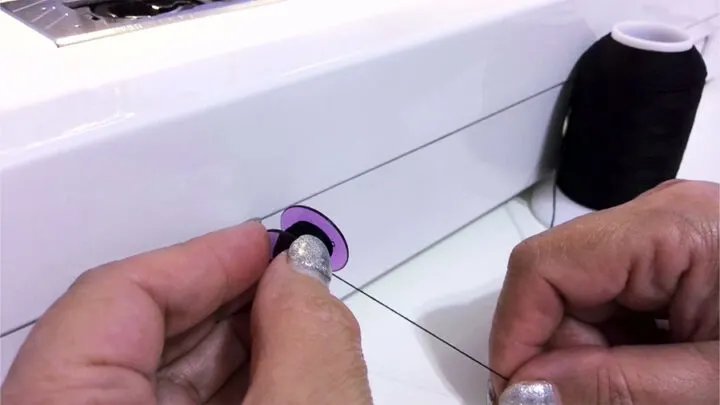
Wooly nylon thread is very good for use with a twin needle. So if you want to sew hems on knit garments without a coverstitch machine you should try to use a twin needle and put wooly nylon thread in the bobbin. Wooly nylon thread will help you to avoid the tunneling effect that’s often happening if you sew with a twin needle.
✅ Related article: Top Bobbin Thread Holders and Organizers
Here I have an example – I am using double knit fabric, which has moderate stretch; in the twin needle I have polyester threads and the wooly nylon thread is in the bobbin.
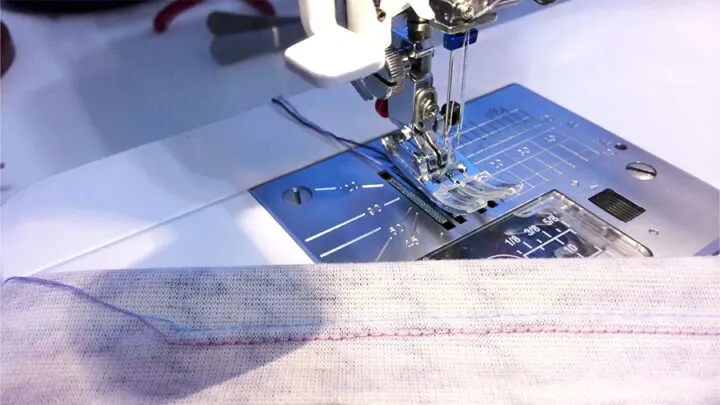
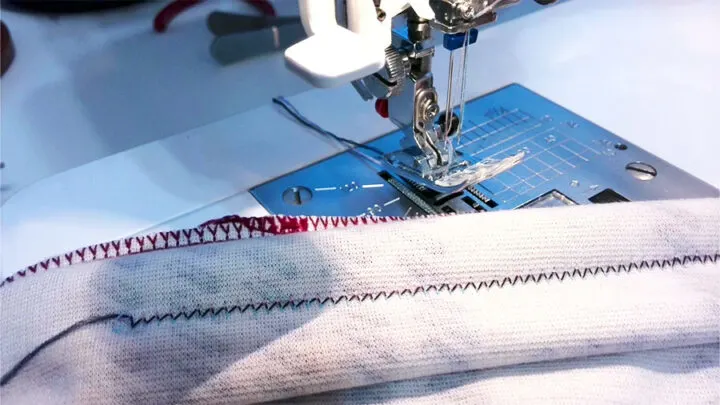
Make sure you read my tutorial on how to use a twin needle because you would need to know a lot of small details to use it successfully.
But I don’t use wooly nylon often on my sewing machine. In fact, apart from some tests I made I don’t remember really using the thread at all on my sewing machine. As soon as I got a serger, I used that exclusively when I needed to sew stretch fabric.
Hint: if you use stretch fabric a lot, consider investing in a serger. They are not really expensive nowadays and they are excellent for many jobs, not only for stretch fabric but also for regular fabric. Check out my article Best serger for beginners – Serger buying guide.
Wooly nylon thread on a serger (overlock)
The serger is the North American name given to what in the rest of the world is known as an overlock machine. I will use the term in the article but please remember that there is no difference (apart from the name) between a serger and an overlock.
A serger has three or four threads (some have more, but those are special cases), two needles and two loopers, which are the equivalent of the bobbin in a sewing machine. I prefer to use a 4 thread 2 needle serger stitch when I use my serger for sewing seams (not overlocking raw fabric edges).
The stitches with only three threads are less secure because they lack the second row of straight stitches parallel to the edge of the material. Three threads are good for overcasting in my opinion, for actual sewing not so much.
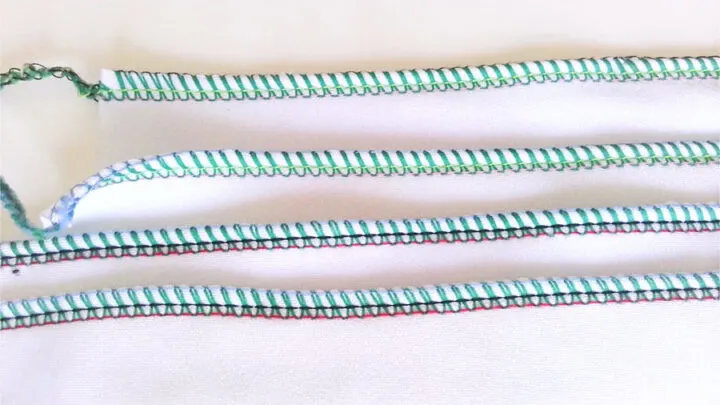
Where does wooly nylon thread go on a serger
The general accepted wisdom is to use the wooly nylon in the loopers only and regular threads in the needles. That will allow the stitch to stretch a reasonable amount.
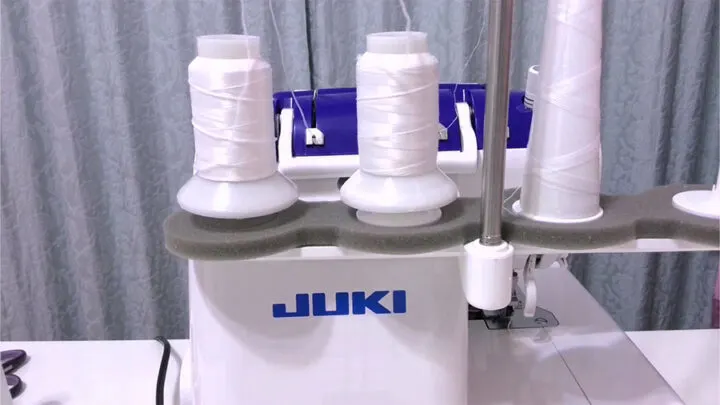
But this is not an absolutely necessary rule. If you want you can use wooly nylon in one of the loopers only ( an upper looper or lower looper), or you can also thread needles with wooly nylon threads.
Do you make these 15 mistakes with your serger?
Enter your email in the box below to download your free eBook and find out which mistakes you should avoid!
Subscribe to my weekly newsletters with sewing tips and tutorials, free sewing patterns, printable PDFs, and other useful content and you’ll find the eBook in your inbox.
Subscriber exclusive offer.
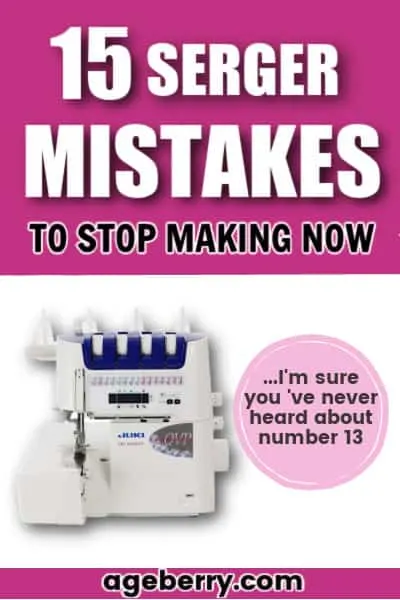
When I am sewing knits I prefer to use wooly nylon threads in both loopers because I like to have the same kind of thread on both sides of a seam. I also like to use wooly nylon in the needles from time to time, and this works very well on all my sergers. I have tested this in my Juki MO-2000, Janome 990D, and also in an older Bernette Funlock. All three worked very well with the wooly nylon in all needles and loopers. However, remember that even if it works, it is not necessary especially since the wooly nylon thread is not cheap.
This test stitch was done with wooly nylon threads in both loopers and both needles and the fabric is spandex.
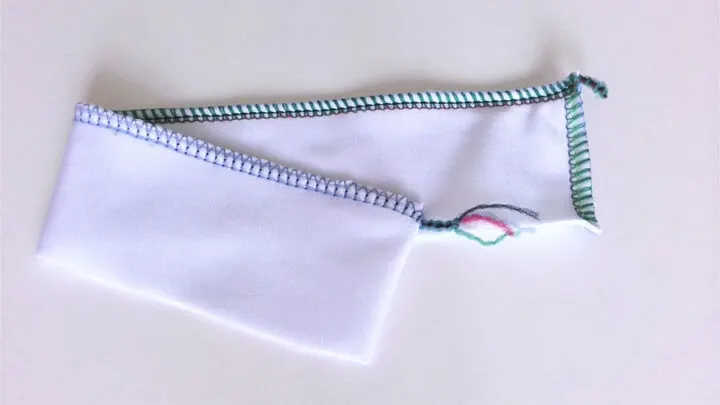
The conclusion that I reached is that indeed if one uses the wooly nylon in all 4 threads, the seam is more stretchy. But consider: do we really WANT the material to be stretched to its limit during normal wear? Stretched to the limit, the elastic material might lose its properties in time and become permanently stretched, so we probably want to avoid this.
You should always test your stitches on scrap fabric and make necessary adjustments before starting your project.
Wooly nylon on a coverstitch machine
I use wooly nylon quite often in my Janome 1000CPX, and as with the serger, the thread needs to be used in the looper. Unlike the serger, here the needle threads are very visible, so the wooly nylon can be used as embellishment too, in which case you will use it in the needles also.
I have tested using the thread in the needles on my machine and it worked well. However, for functional purposes, it is enough to use it in the looper, the same as in a serger.
How to thread a serger with wooly nylon
People often wonder how to thread a serger with wooly nylon thread.
It’s actually very simple. The method is called quick-change threading and you can use it for regular sergers and modern self- threading sergers too. If the loopers are already threaded with regular thread (as it will be often the case), cut the thread that will be replaced by the wooly nylon near the spool holder, remove the regular thread cone, put the wooly nylon spool in the holder, and tie the end of the regular thread to the beginning of the wooly nylon.
Check the knot to be sure it’s secure before continuing. Turn the tensions to their lowest settings so there will be no tension in the disks. Or you can just put up the presser foot with some models of sergers. This will prevent the knot from untying as you draw the new thread through the machine.
Then pull the thread until the regular thread is out and the wooly nylon reaches the looper. If a thread doesn’t go easily check whether it’s caught on the thread guide or wrapped around the thread stand.
Return the tensions to their previous settings. Make sure threads have slipped completely between the discs.
While holding the thread ends behind the presser foot, tum the handwheel a couple of times to be sure the stitches are forming on the stitch finger. Then serge slowly to form a new thread chain.
If the loopers are not threaded yet, thead it with a regular thread, then perform the step above. Do not try to thread directly with wooly nylon, you may or may not succeed, but I can guarantee that you will have absolutely no fun trying.
Threading serger needles with wooly nylon is indeed problematic. You can’t use regular thread to knot the wooly nylon to it because the knot would not go through the needle eye. Well, the solution is still very simple – USE A DENTAL FLOSS as a threader.
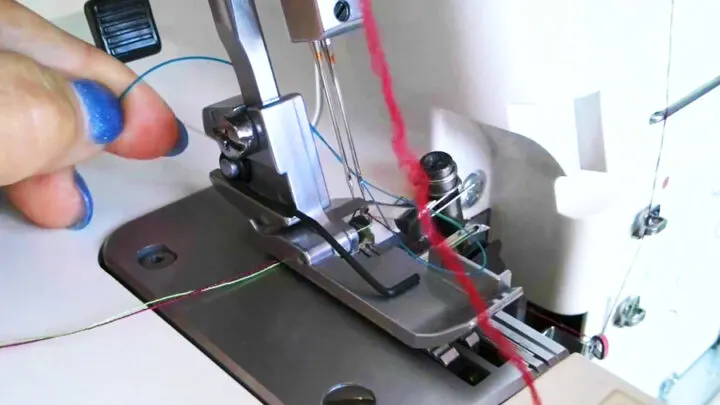
Note: you will only thread a serger or coverstitch machine with wooly nylon. A regular sewing machine will only use wooly nylon in the bobbin.
Where to buy wooly nylon thread
The thread is for sale in all the places that sell threads, both online and traditional stores. For example this is an Amazon link. I prefer Amazon because of its excellent return policy and because I am a Prime member, I do not need to worry about the shipping costs. Their prices are also very competitive most of the time and for threads (of all kinds, not only wooly nylon) I have always found good deals on Amazon.
The color range for wooly nylon thread, when compared to polyester or embroidery threads, might be somewhat limited: you will probably not find 250 distinct colors. But still, you can find a sufficient number of options. For example, ThreadArt has 50 colors available so you can find the perfect shade to match your fabric.
Brands of wooly nylon
I own and use many brands of wooly nylon. Among them ThreadArt, MaxiLock (or Maxi-Lock, or Maxi Lock, it’s an American and Efird brand), YLI Corporation, Superior Threads, A Brand Threads. All of them perform as expected and I haven’t really noticed a big difference between them.
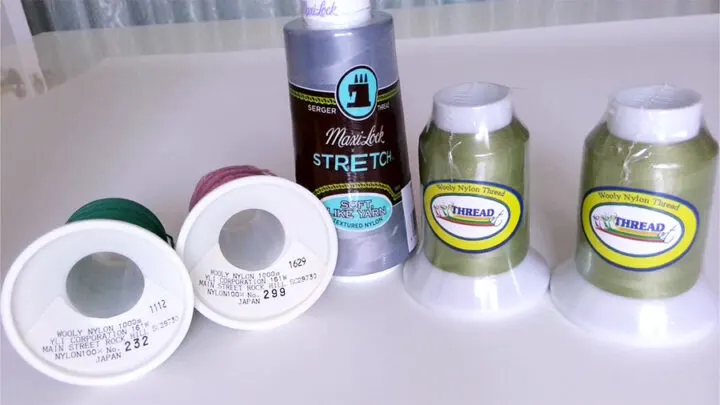
I have seen other brands too which I didn’t test, for example, Glide and Isacord.
I strongly recommend against using a no-name thread unless you have tested it before use. Thread is not expensive and in my opinion, you can’t afford to use low-quality thread while working and risk wasting hours of work. Unless of course, you want to practice using the seam ripping tool 😀!
Be sure to check out this selection of wooly nylon thread from SewingMacxhinesPlus.com to find the perfect one for your projects.
What weight is wooly nylon thread
Very few manufacturers actually mark their wooly nylon threads with a weight, tex or den size. I have seen wooly nylon threads marked with a simple number. ThreadArt, for example, has #200 on their spools. While I am not sure, I suspect the number is the den (denier) of the thread.
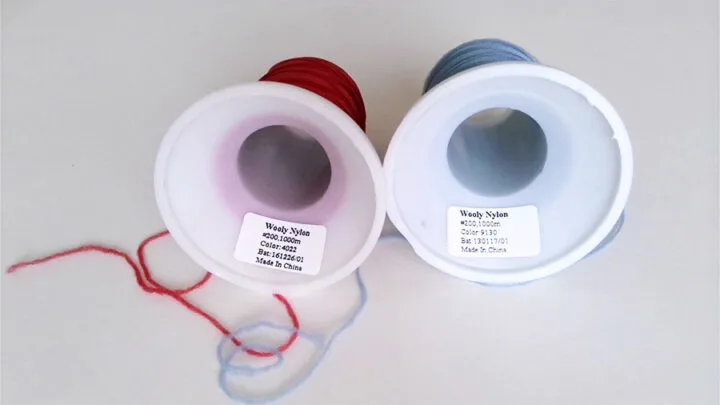
For a better understanding of the thread weight and its various methods of classification please refer to my article Sewing thread sizes how to choose.
Here is wooly nylon thread by A Brand Threads. The T-24 is clearly a tex value.
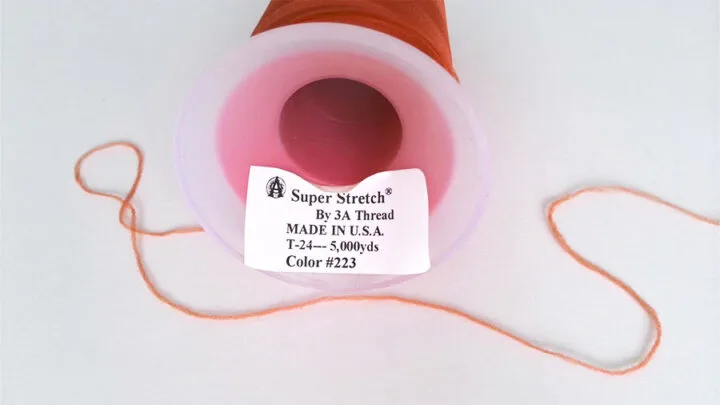
The third thread (YLI corporation) has no weight marking.
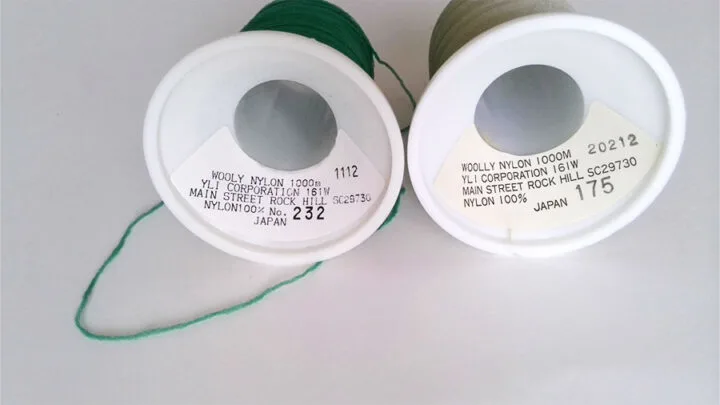
So I assume (as a user) regular wooly nylon threads are tex 23 or 24 as in the image. “Den # 200” translates into tex 22 – 23. Nylon is already a relatively strong thread, a regular tex 23 thread is not easy to break by hand and is probably on par with core spun polyester of a similar weight (about W40). It is difficult to assess the strength by hand, so this is only my personal opinion.
In Conclusion: Wooly nylon thread is a great option for your sewing projects because of its high elasticity, softness, durability, vibrant shine, and strength. It can be used for a variety of different projects, from garments to home décor items. Be sure to check out the big selection of wooly nylon threads to find the perfect one for your project!
Did you find this tutorial helpful? If so, save this pin (see below) on your sewing board so you can come to this tutorial later when you are ready to use wooly nylon thread, and follow me on Pinterest for more tips, tutorials, and inspiration!
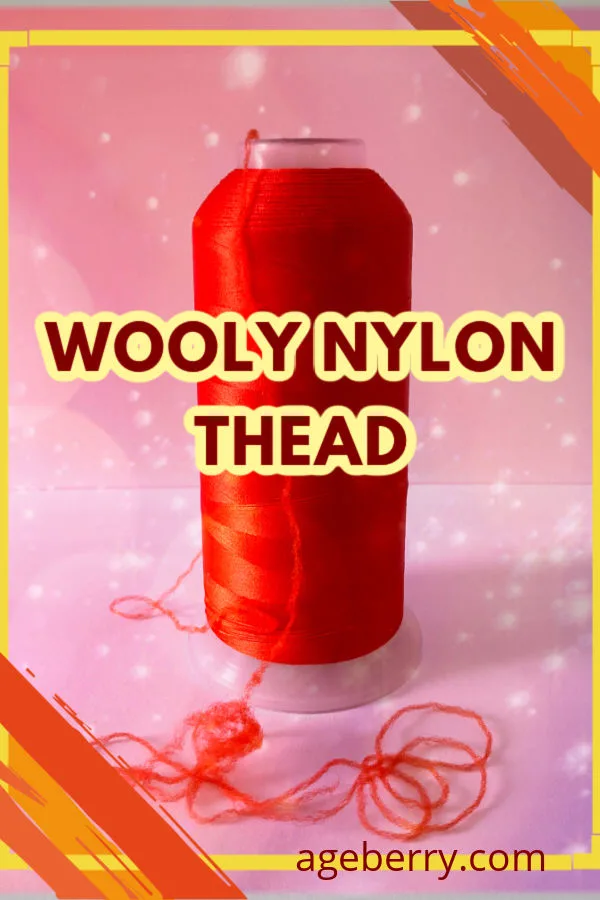
FAQ about wooly nylon thread
Wooly nylon thread is a specially designed stretch thread that is made from 100% nylon and known for its high elasticity, softness, durability, vibrant shine, and strength. It’s great for swimwear, athletic wear, activewear, lingerie, and garments that need a little extra stretch.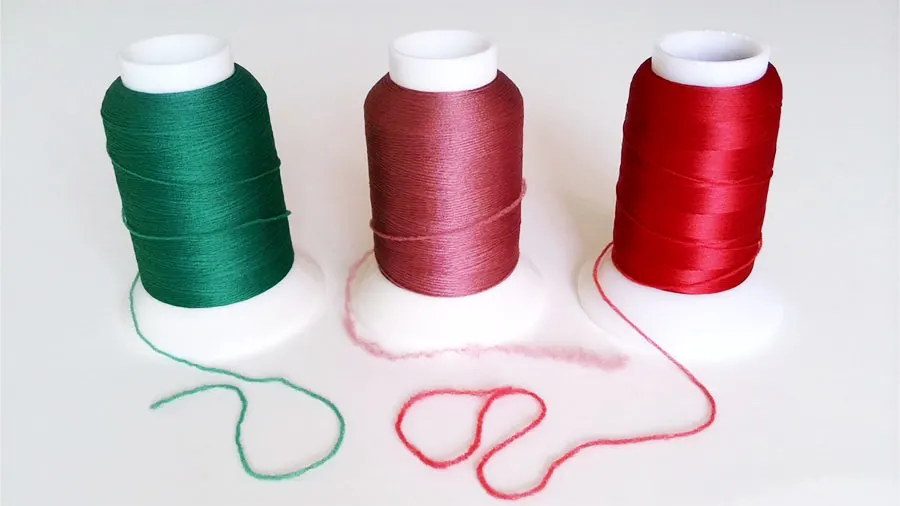
Yes, you can use wooly nylon in a regular sewing machine for sewing stretchy fabrics. Just make sure that you use it in the bobbin only, as it can cause problems if threaded in the needle. A stretch stitch needs to be used to sew with wooly nylon.
Yes, wooly nylon thread is very stretchy. It’s made from a nylon fiber that’s specifically designed to be stretchy and durable. It’s a very popular thread for making swimwear, lingerie, and dancewear because of its ability to stretch. But not all wooly nylon threads stretch the same.
Maxi lock stretch thread is a very similar thing to wooly nylon but described as textured nylon by the manufacturer. It’s also a stretch, soft, durable fuzzy thread with vibrant shine. Sometimes various wooly nylon threads can be seen under different names.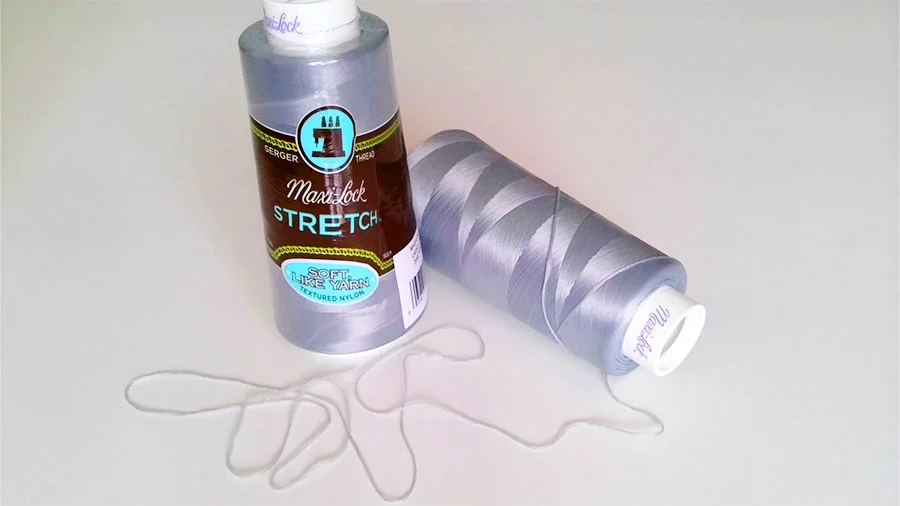
latest posts
- Ever Tried This on Your Serger? This Differential Feed Feature Will Amaze You
- Ditch My Sewing Machine? Not in This Lifetime!
- Adorable DIY Needle Book | Easy Tutorial for Beginners
- Master the Seam Ripper: Your Ultimate Guide to Precision Stitch Removal
- Think You Know Zippers? This Installation Guide Might Surprise You
- Why Does Your Seam Ripper Have a Red Ball? Discover Its Purpose!
- Topstitching Troubles? This Simple Trick Will Turn It Around Instantly!
- How to Sew Shirring: A Step-by-Step Guide to Elastic Thread Gathering
- Are Self-Threading Needles Really Useful?
